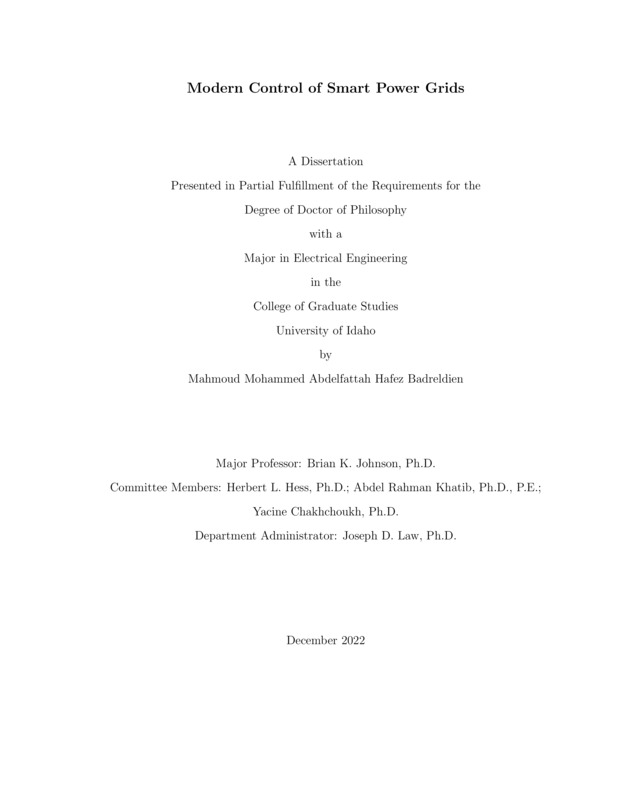Modern Control of Smart Power Grids
Badreldien, Mahmoud Mohammed Abdelfattah Hafez. (2022-12). Modern Control of Smart Power Grids. Theses and Dissertations Collection, University of Idaho Library Digital Collections. https://www.lib.uidaho.edu/digital/etd/items/badreldien_idaho_0089e_12474.html
- Title:
- Modern Control of Smart Power Grids
- Author:
- Badreldien, Mahmoud Mohammed Abdelfattah Hafez
- ORCID:
- 0000-0003-0515-5354
- Date:
- 2022-12
- Program:
- Electrical and Computer Engineering
- Subject Category:
- Electrical engineering; Energy
- Abstract:
-
The desire to reduce the carbon emissions footprint caused by fossil-fueled power plants has increased penetration of renewable energy resources based distributed generating units, in particular photovoltaic plants and wind energy conversion systems, in the power system network. Furthermore, the topology and architecture of the power system have changed from one with large conventional generation to one with distributed architectures. This thesis describes microgrid architectures, their control strategies and the distributed generating units that are used to supply the microgrids. The modeling, design, and control for a wind energy conversion system are described. The work includes a doubly-fed induction generator combined with a battery energy storage system. Photovoltaic power represents most of the new microgrid power sources in the literature. Modeling and control of a solar photovoltaic system are also described in the thesis. An energy storage system is connected in parallel with the photovoltaic system. The battery overcomes the intermittent nature of both wind speed and solar irradiation levels. The proposed system is modeled and simulated in different scenarios to verify the proposed control system and its operation to control the active and reactive power and terminal voltage. Expansion of renewable energy resources with common control schemes that have low inertia to replace conventional generators tends to reduce the total system inertia. Reduction of the inertia could have a dramatic effect on power system stability. Converter control schemes that create virtual synchronous generators were adopted in the literature to address the inertia reduction and stability challenges. The power converters are controlled to emulate and improve the features of the traditional synchronous generator such as inertia and damping, to improve system stability. A proposed control strategy, mathematical model, and controller design will be described in this thesis. Applying a virtual synchronous generator works best with an energy storage system. A hybrid energy storage system composed of superconducting magnetic energy storage and a battery is used to smooth the system's power fluctuations. The superconducting magnetic energy storage system deals with the high rate of change of power fluctuation. On the other hand, the battery system deals with slower power fluctuations. This hybrid system reduces the stress on the battery by removing the transient and high rate of change of charging and discharging currents to increase lifetime. Furthermore, virtual synchronous generator parameters can be set according to the desired and best performance without being limited by the characteristics of a physical synchronous generator, Moreover, these parameters and constants affect the sizing of the converter and the energy storage system size. When the inertia time constant increases, the system has larger amplitude power oscillations and it counteracts the frequency change. Also, the damping constant affects the system performance. When the damping constant increases, the system has lower amplitude power oscillations and it takes lower time to reach the new steady-state value. The simulation results describe how the inertia and damping constants affect the system operation and performance. Moreover, they show the power and energy required to achieve a desired performance of the virtual synchronous generator. However the superconducting magnetic energy storage system is more expensive than the battery, it may be more effective and cheaper in some applications such as in fast charge and discharge, and deep depth of discharge ones. Furthermore, virtual synchronous generator controllers combined with ESSs play a vital role to spread renewable energy generators and microgrid concepts. Hence, this helps to optimize using the available energy resources, and minimize conventional fuel consumption and greenhouse gas emissions.
- Description:
- doctoral, Ph.D., Electrical and Computer Engineering -- University of Idaho - College of Graduate Studies, 2022-12
- Major Professor:
- Johnson, Brian
- Committee:
- Hess, Herbert; Chakhchoukh, Yacine; Khatib, AbdelRahman; Law, Joseph
- Defense Date:
- 2022-12
- Identifier:
- Badreldien_idaho_0089E_12474
- Type:
- Text
- Format Original:
- Format:
- application/pdf
- Rights:
- In Copyright - Educational Use Permitted. For more information, please contact University of Idaho Library Special Collections and Archives Department at libspec@uidaho.edu.
- Standardized Rights:
- http://rightsstatements.org/vocab/InC-EDU/1.0/

